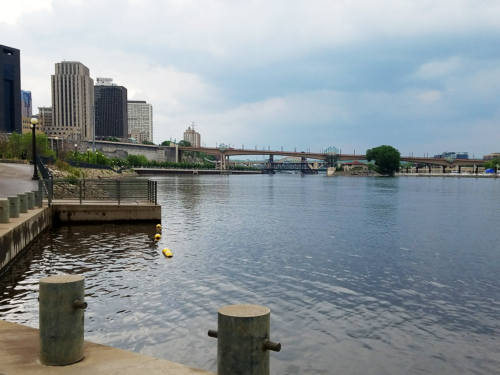“The most livable city in America”
Caroline Donovan ·During the week of May 15th, I traveled to St. Paul, Minnesota, to attend and present at the 2017 Citizen Science Association Conference. Alex Fries and Suzi Spitzer from IAN also attended the conference. Check out Suzi’s awesome blogs on the conference.
St. Paul is the capital of Minnesota and adjoins Minneapolis, which is the largest city in Minnesota. While the combined St. Paul-Minneapolis population is 3.52 million (Wikipedia), St. Paul itself is much smaller and feels like a friendly town more than a big city. When I arrived in the city, I immediately set out to walk to the Mississippi River. During the Mississippi River report card project, several IAN staff traveled throughout the watershed, including to the Quad Cities in Illinois/Iowa. Now, here I was in St. Paul, MN even farther north on the Mississippi! St. Paul sits at the confluence of the Mississippi and Minnesota Rivers, which defines the pattern of development and open space in the area.

The river looked very similar to the other places I have seen it – a river boat parked on the shoreline and long bridges crossing back and forth. However, this particular stretch of the river is part of a 72-mile park, Mississippi National River & Recreation Area. There are picnic areas, walking paths, and bicycles for rent.


I then walked northeast to the downtown area, which was quite charming and picturesque. There are several parks, the Landmark Center, and the skyway bridges that connect all the buildings. Rice Park, named after Henry M. Rice, a U.S. senator and fur trade intermediary, is the center of the historic downtown. The fountain in the center is the main attraction, but there are also some of the Peanuts statues that are sprinkled throughout the city to honor the cartoonist Charles M. Schulz, who was born and raised in St. Paul. The Landmark Center is a cultural center that is owned by the city. Even though it is a historical landmark, it has also been awarded the 2016 Energy Efficiency and Conservation Building Award by the city.


One interesting feature of downtown St. Paul is the skyway bridges that connect the labyrinth of office and shopping buildings. These bridges can be used any time of the year, but are a welcome relief in the cold, snowy winters!


Plaque honoring the developed the skyway bridges. Image credit: Caroline Donovan
There were many other places to visit in St. Paul, such as the Cathedral of St. Paul and the Science Museum of Minnesota, but I only had a short time to soak in the friendly atmosphere and interesting sights of “the most livable city in America!”
About the author
Caroline Donovan

Ms. Caroline Donovan oversees program and project management, science communication, and data analysis at UMCES-IAN. She has over 15 years of experience with ecosystem health report cards, science communication products, stakeholder engagement, and citizen science and volunteer monitoring. Ms. Donovan has worked extensively in the fields of science integration and communication, facilitation, and program management and administration. Ms. Donovan received a Bachelor of Science in Biology from University of North Carolina - Wilmington in 2002 and a Master of Science in Biological Oceanography from University of Maryland - College Park in 2005.
Next Post > Finalizing the Guanabara Bay Report Card
Comments
-
Essay writer 9 years ago
Very true, St. Paul though small is much friendlier than a big town...Great article

